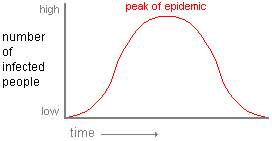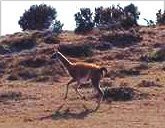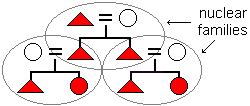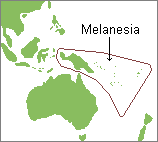Glossary of Terms
A B C D E F G H I J K L M N O P Q R S T U V W X Y Z
Select the first letter of the word you are seeking from the list above
to jump to the appropriate section of the glossary or scroll down to it
- A -
- aquatic

- having to do with water. (derived from the Latin word aqua meaning water). See aquatic foraging.
- aquatic foraging
- a specialized subsistence pattern that concentrates on fish and/or marine mammal hunting. Aquatic foraging is usually a far more reliable and productive strategy for obtaining food than the diversified hunting and gathering of most foragers who live away from the coasts and major rivers. The most well known aquatic foragers lived on the Northwest Coast of North America from the Klamath River of California to the Aleutian Islands of Alaska. These societies specialized in salmon fishing along the rivers and hunting seals and whales off the coast.
Back to Top
- B -
- band

- the kind of political
system found among most foraging societies. It
consists of a few families living together without formal leadership.
As a result, bands are referred to as being simple acephalous
 (or
headless) societies.
There are no special integrative mechanisms other than those available to
all types of societies--i.e., kinship and personal persuasion.
Political power is diffused or dissipated and decision making is highly
democratic. There
is a horizontal status relationship between all adults of the same sex--i.e,
they are all equal as far as decision making is concerned. As a
result, there is no individual who can speak for the community on all
matters in dealing with outsiders.
(or
headless) societies.
There are no special integrative mechanisms other than those available to
all types of societies--i.e., kinship and personal persuasion.
Political power is diffused or dissipated and decision making is highly
democratic. There
is a horizontal status relationship between all adults of the same sex--i.e,
they are all equal as far as decision making is concerned. As a
result, there is no individual who can speak for the community on all
matters in dealing with outsiders.
Back to Top
- C -
- clan

- a group of people who claim unilineal descent from the same ancestor but who cannot specify all of the actual links. The ancestor is genealogically so remote that he or she is often thought of as a mythical being, animal, or plant. Clans usually consist of a number of related unilineages. See totem.
- cyclical
round of migrations

- seasonal migrations of foragers or pastoralists between different environments in their territories. This often involves migrations that take people from spring to summer camps and then to fall and finally winter ones. This cycle of migrations that is repeated yearly is determined by the resources that can be exploited at particular times of the year in different areas. Carrying out such a round of migrations increases the amount of food that can be obtained by a society. As a result a somewhat larger population can be supported.
Back to Top
- D -
- diversified
foraging

- a hunting and gathering subsistence pattern in which there is not a concentration of efforts in harvesting a small number of species. Rather, virtually all potential food sources in the environment are exploited. Most pedestrian foragers take a diversified approach. In contrast, aquatic and equestrian foragers are specialized. A diversified subsistence pattern has the advantage of relative economic security if there are fluctuations in the weather, water supply, or periodic die-offs of the food sources. The disadvantage is that the total amount of food calories acquired is often less and the amount of time required to secure them is greater compared to specialized foraging.
- division of labor
- referring to the jobs that are normally assigned to people based on such things as gender and age. In most foraging societies, large animal hunting is an occupation of adult males, while domestic tasks, child rearing, and plant food collecting are mostly adult female jobs. In the Western industrialized nations today, the division of labor is based mostly on age, knowledge, skills, and preference. Gender is often rejected as a criteria for job assignment in these contemporary societies.
Back to Top
- E -
- egalitarian

- referring to societies in which all people are equal in terms of economic and political rights. Foraging bands are the most egalitarian societies. However, even in these societies, there are differences based on age and sometimes gender.
-
epidemic

- the occurrence of a disease in a population in which it appears, rapidly spreads between people, reaches a high frequency, and then subsides. Contagious diseases such as influenza, measles, and AIDS follow this epidemic pattern.
 |
- equestrian

- having to do with horses. (derived from the Latin word equus meaning horse). See equestrian foraging.
- equestrian foraging
- a specialized subsistence pattern in which horses are used extensively in hunting large game animals. Equestrian foragers evolved in only two areas of the world--the Great Plains of North America and the sparse grasslands of Southern Argentina. In both cases, pedestrian foragers acquired horses from Spanish settlers in the early 17th century. Over several generations, horse breeding and riding skills were honed. This resulted in a revolutionary change in these Native American societies. The horse became the principle mode of transportation and dramatically increased hunting success in the pursuit of large animals. These societies became larger, more mobile, and were now able to travel over larger areas throughout the year. Horses allowed them to effectively follow the seasonal migrations of large herbivores over hundreds of miles. In North American the prey of choice was the bison and in South America it was the guanaco.
- ethnocentrism

- the feeling that your own group's cultural traditions and values are correct and superior to all others. This is usually coupled with a generalized dislike and even contempt for people who have other cultural traditions. Ethnocentrism is universal in that all people around the world are ethnocentric to some degree.
- ethnography

- a descriptive and usually interpretive study of an individual culture.
- extended family
- two or more nuclear families tied together by bonds of descent. Usually an extended family contains living relatives from three or more generations.
Back to Top
- F -
- foragers

- people who live in more or less isolated, small societies and obtain their food by foraging wild plants and hunting wild animals. Foragers generally have a passive dependence on what the environment contains. They do not plant crops and the only domesticated animals that they usually have are dogs. Most foraging societies do not establish permanent settlements. Rather, they have relatively temporary encampments with tents or other easily constructed dwellings. The length of time that they stay in any one location is largely determined by the availability of resources. Foragers are also referred to as hunters and gatherers.
Back to Top
- G -
 |
- guanaco

- a species of small wild camelids with reddish-brown fur that live mainly on the sparse grasslands of southern Argentina. Guanacos are closely related to the domesticated llamas, alpacas, and vicuñas of the Andes Mountains in western South America.
Back to Top
- H -
- herbivorous

- eating only vegetable foods. Animals that have this sort of diet are herbivores or vegetarians.
- hierarchical
society

- a society that is divided into unequal social classes and individual statuses. There commonly is a ranking of classes and statuses in hierarchical societies such that those that are at the top of the ranking have greater power and wealth. Large intensive agriculture based societies typically have a social and political pyramid with an elite ruling class at the top and the majority of the people at the bottom.
- horticulturalists

- people who obtain most of their food by low intensity farming. This subsistence pattern involves at least part time planting and tending of domesticated food plants. Pigs, chickens, or other relatively small domesticated animals are often raised for food and prestige. Many horticultural societies supplement their farming subsistence base with occasional hunting and gathering of wild plants and animals. They usually practice slash and burn field clearing methods and do not add additional fertilizer or irrigate. Multi-cropping is common. They often have a partial reliance on foraging for wild foods. Their societies are usually larger and more sedentary than those of foragers but still are at a low technological level and relatively small-scale.
- hunters and gatherers
- see foragers.
Back to Top
- I -
- indigenous

- referring to the native population of an area.
-
intensive
agriculture

a subsistence pattern characterized by full-time farming in which large beasts of burden or highly mechanized farm equipment (e.g., rototillers and tractors) are used to prepare the land for planting and later to harvest crops. Intensive agriculture usually involves the use of irrigation or other forms of water management. Often there is mono-cropping with heavy applications of fertilizers, pesticides, and herbicides. This form of agriculture is highly productive but generally capital intensive.
Back to Top
- J -
Back to Top
- K -
Back to Top
- L -
- large-scale farming
- see intensive agriculture.
- large-scale society
- generally a society with cities, industry, intensive agriculture, and a complex international economy. Such societies have socio-economic classes and a government with hierarchies of officials. The importance of kinship is diminished in social, economic, and political matters (in comparison to small-scale societies).
Back to Top
- M -
- mechanized grain farming
- intensive farming for the production of cereals (e.g., corn, wheat, oats) in which hundreds and even thousands of acres are planted, tended, and harvested by a small number of people using large machinery (e.g., tractors and combines). There usually are heavy applications of fertilizers, pesticides, and herbicides. This highly productive form of intensive mono-cropping agriculture is capital but not labor intensive. The Great Plains of North America is predominantly a region of mechanized grain farming.
- Melanesia

- New Guinea and other nearby islands in the Southwest Pacific Ocean. Indigenous people from this region are referred to as Melanesians.
-
Mesoamerica

- Southern Mexico and northern Central America. This was the main center of early plant domestication and ancient civilizations in North and Central America.
- mono-cropping

- planting a crop of only one species in a farm field. This is a common practice with intensive agriculture. While this can be a highly efficient farming strategy, it results in crops that are more susceptible to being wiped out by insects and other parasites. Mono-cropping is also known as "mono-culture". See multi-cropping.
-
multi-cropping

- planting a farm field with more than one species. This is a common practice among horticulturalists. Multi-cropping reduces the chances of total crop failure due to insects and other parasites. However, it is far more labor intensive to plant, tend, and harvest. See mono-cropping.
-
multinational
corporation

a corporate business that has outgrown its national roots and identity as it became multinational with facilities in many countries and no overriding feeling of obligation or loyalty to any one of them. Such companies typically move their production facilities from nation to nation in response to labor costs and tax advantages. As a result, they are generally independent and beyond the control of any one national political system. Multinational corporations have had a major impact on previously isolated indigenous societies in the late 20th century. Multinational corporations are also known as transnational corporations.
Back to Top
- N -
-
nomadism

- see pastoral nomadism.
-
nuclear
family

- a family generally consisting of a man, woman, and their children. See extended family.
Back to Top
- O -
Back to Top
- P -
-
parasitic
disease

- a disease caused by an organism that lives on or in the body and derives its sustenance from it, usually without being any benefit to the host. Most parasitic diseases of humans in industrialized nations are caused by viruses, bacteria, fungi, protozoa, or other microscopic organisms. In poor developing nations, parasites may also include macroscopic organisms such as worms.
-
pastoralists

- people who make their living by tending herds of large animals. The species of animals vary with the region of the world, but they are all domesticated herbivores that normally live in herds and eat grasses or other abundant plant foods (e.g., cattle, horses, sheep, reindeer). Traditional pastoralists are essentially subsistence herders who form small-scale societies. There are essentially two forms of pastoralism--nomadism and transhumance.
-
pastoral
nomadism

- traditional pastoralists who follow a seasonal migratory pattern that can vary from year to year. The timing and destinations of migrations are determined primarily by the needs of the herd animals for water and fodder. These nomadic societies do not create permanent settlements, but rather they live in tents or other relatively easily constructed dwellings the year round. Pastoralist nomads are usually self-sufficient in terms of food and most other necessities. See transhumance.
-
patrilineal
descent

 |
- unilineal descent that follows the male line. With this pattern, people are related if they can trace descent through males to the same male ancestor. Both males and females inherit a patrilineal family membership but only males can pass it on to their descendents. Also known as "agnatic descent".
-
pedestrian

- having to do with walking. (derived from the Latin word pedester meaning "on foot"). See pedestrian foraging.
- pedestrian foragers
- people whose subsistence pattern involves diversified hunting and gathering on foot rather than horseback. The pedestrian hunting and gathering way of life was mobile. Most of these societies moved their camps several times a year and had temporary dwellings. The number of people living in a camp also often varied throughout the year depending on the local food supply. Material possessions were generally few and light in weight so that they could be transported easily. Subsistence tools included such things as simple digging sticks, baskets, spears, and bows and arrows that could be easily replaced when needed. This settlement flexibility is an efficient way of responding to changing environmental opportunities. See foragers.
- plantation agriculture
- large, labor-intensive farms that mostly produce fruit, sugar, fiber, or vegetable oil products for the international market. The laborers usually work for very low wages that keep them in poverty. Many of the plantations of Indonesia, the Philippines, Central America, the Caribbean, and West Africa are owned by multinational corporations such as Dole and the National Fruit Company. The net effect of this form of agriculture generally has been the flow of wealth from poor nations in the Southern Hemisphere to rich ones in the Northern Hemisphere.
-
polyandry

- the marriage of one woman to several men at the same time. This is a rare type of polygamy. It usually takes the form of "fraternal polyandry", which is brothers sharing the same wife.
-
polygamy

- the generic term for marriage to more than one spouse at the same time. It occurs as polygyny or, more rarely, polyandry.
-
polygyny

- the marriage of one man to several women at the same time. This is the most common form of polygamy. It often takes the form of "sororal polygyny", which is two or more sisters married to the same man.
-
positive
correlation

- a strong association between two different phenomena such that when one is the present, the other is as well. For example, in the United States today, people who have college degrees usually earn more money during their lifetimes than do people who have only gone to high school. It is important to keep in mind that a positive correlation does not necessarily imply a cause and effect relationship between the co-occurring phenomena.
Back to Top
- Q -
Back to Top
- R -
-
reciprocity

- the situation in which an individual gives something to another person and in the process sets up a relationship between them such that they are both obliged to give, receive, and ultimately repay gifts. These reciprocal exchanges tend to create a continuing social bond between the individuals.
Back to Top
- S -
-
shifting
agriculture

- the horticultural practice
of shifting from one field to another when crop production drops due to the
inevitable depletion of soil nutrients. Shifting agriculture is also
referred to as "swidden cultivation"
 .
.
-
slash
and burn

- the method used by horticulturalists to clear fields of heavy vegetation in preparation for planting new crops. Brush and small trees are cut down and allowed to dry out in place. They are then burned. This simultaneously clears the field of all but large trees and adds ash to the soil surface. The ash acts as a fertilizer. No other fertilizer is applied to the field. As a result, soil productivity lasts only for a few years.
- small-scale farming
- farming using horticultural techniques.
- small-scale society
- generally a society of a few dozen to several thousand people who live by foraging wild foods, herding domesticated animals, or non-intensive horticulture on the band or village level. Such societies lack cities as well as complex economies and governments. Kinship relationships are usually highly important in comparison to large-scale societies.
- specialized foraging
- a foraging subsistence pattern in which a limited number of species are hunted or gathered. Aquatic and equestrian foragers usually are specialized in their food quest. Specialized foraging can be highly productive but is risky in environments that experience periodic droughts or other significant environmental changes that affect the food supply. See diversified foraging.
-
subarctic

- the area surrounding the arctic circle. In the Western Hemisphere, this includes the northern regions of Alaska and Canada. Subarctic also refers to the cold climates of these regions. Most subarctic regions are tundra.
-
subsistence
base

- the main sources of food used by a society. The term "subsistence base" is often used interchangeably with subsistence pattern.
-
subsistence
pattern

- the methods a society uses to obtain its food and other necessities (e.g., foraging, pastoralism, horticulture, and intensive agriculture). The term "subsistence pattern" is often used interchangeably with subsistence base.
Back to Top
- T -
-
temperate

- referring to the regions of the world mostly in the middle latitudes where winter temperatures regularly fall below freezing and summers are warm. In the Northern Hemisphere, the temperate regions are south of the colder subarctic and north of the subtropics. Temperate regions often have deciduous and evergreen forests, but they are too cold to grow such tree crops as oranges and avocados outside of a greenhouse.
- third world
- Societies that are underdeveloped.
-
totem

- a mythical
clan
founding ancestor. Totem origins are so far back in time that
they are often believed to be non-human. Totems are used as
symbols of clans. When they are believed to be particular kinds of
animals or plants, killing or eating them is usually not allowed.
Totems are also referred to as "totemic emblems"
 .
The "totem poles" made by the aquatic foraging Indians of
Vancouver Island in Western Canada were often graphic representations of
their totems and of supernatural beings.
.
The "totem poles" made by the aquatic foraging Indians of
Vancouver Island in Western Canada were often graphic representations of
their totems and of supernatural beings. -
transhumance

- a cyclical pattern of migrations made by some pastoralists that usually take them to cool highland valleys in the summer and warmer lowland valleys in the winter. This is seasonal migration between the same two locations in which they have regular encampments or stable villages often with permanent houses. See pastoral nomadism.
-
transnational
corporation

-
tundra

- treeless regions with permanently frozen soil. Tundra environments are found in the subarctic regions of the world and in some high mountains.
Back to Top
- U -
- underdeveloped society
- a society in which most of the people are persistently poor due to the way they are integrated into the world economic system. They usually provide cheap raw materials and labor for the rich, developed nations and purchase their manufactured goods at high prices. The economies of underdeveloped societies are largely dependent on the richer nations. Bangladesh and Guatemala are examples of underdeveloped nations. They are also referred to as "third world" or "developing" nations. See undeveloped society.
- undeveloped society
- a largely isolated society that has a low technological level but is economically self-reliant. They are not participants in the world economic system. Such societies mainly consist of indigenous peoples who have subsistence economies. By definition, undeveloped societies are not underdeveloped. Tibet and Afghanistan up until the 1950's are examples of undeveloped societies.
-
unilineal
descent

- tracing kinship only through a single line of ancestors, male or female--i.e., descent links are traced only through ancestors of one gender. See also patrilineal descent.
Back to Top
- V -
Back to Top
- W -
Back to Top
- X -
Back to Top
- Y -
Back to Top
- Z -
Back to Top
This page was last updated on
Monday, September 07, 2009
.
Copyright © 2001-2009 by Dennis
O'Neil. All rights reserved.
Illustration credits

